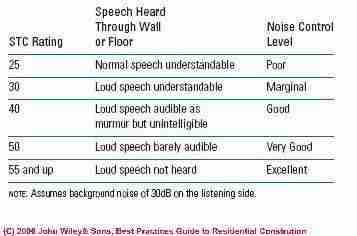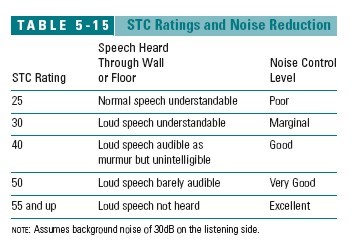 Sound Transmission Class - STC & Sound Reduction Index - SRI & OITC
Sound Transmission Class - STC & Sound Reduction Index - SRI & OITC
- POST a QUESTION or COMMENT about noise & sound transmission through building walls - sound transmission pathways and how to control noise or sound in buildings
STC: Sound Transmission Classes:
Building Noise & Sound Transmission Levels & Sound Isolation or Insulation Measurements.
This article discusses methods for controlling sound transmission through building walls. Here we define STC - sound transmission class and we provide a table of design details that show STC rating for various building wall framing designs. Sound transmission reduction wall designs are given for both single stud and staggered double stud structural and partition walls. We include soundproofing suggestions for high noise level areas such as music rooms as well as areas where privacy is a concern such as in counseling and psychotherapy offices.
InspectAPedia tolerates no conflicts of interest. We have no relationship with advertisers, products, or services discussed at this website.
- Daniel Friedman, Publisher/Editor/Author - See WHO ARE WE?
Sound Transmission Class: What are STC Ratings
This article series discusses noise and sound control in buildings, and includes excerpts or adaptations from Best Practices Guide to Residential Construction (Steve Bliss, J Wiley & Sons) , by Steven Bliss, courtesy of Wiley & Sons.
How effectively a wall or floor reduces airborne sound is measured by STC ratings (sound transmission class). Roughly speaking, the STC rating equals the reduction in decibel levels across the partition. (see Table 5-15).
[Click to enlarge any image]
Definition of STC, Definition of SRI , Definition of OITC
Sound Transmission Class (STC) is defined in the ISO-140 standards series. Sound Reduction Index (SRI) is defined in ISO-140 (2012).
Sound Transmission Class (or STC) is an integer rating of how well a building partition attenuates airborne sound. In the USA, it is widely used to rate interior partitions, ceilings/floors, doors, windows and exterior wall configurations (see ASTM International Classification E413 and E90).
Outside the USA, the Sound Reduction Index (SRI) ISO index or its related indices are used. These are currently (2012) defined in the ISO - 140 series of standards (under revision). The STC rating figure very roughly reflects the decibel reduction in noise that a partition can provide - Wikipedia 10/21/2013 [3]
STC or sound transmission class is defined as the level of reduction of sound transmission from outside noise sources to the building interior. Higher STC numbers mean higher resistance to sound transmission to the building interior, or as acousticians would describe it, higher STC means greater sound transmission loss between outdoors and the building interior. Typical STC values for metal buildings are STC=20 to STC=55.
OITC or Outdoor-Indoor Transmission Class describes the sound transmission loss properties of building exterior components like windows and walls against noise from traffic, trains, or low flying aircraft. - General Steel Corporation [4]
So, for example, a 50 dB noise on the other side of an STC 35 wall will sound like a 15 dB noise to the average listener (see our Table of STC ratings and noise reduction left).
Walls and floors in the field often measure lower than in laboratory ratings due to variations in workmanship as well as leaks and bypasses.
The higher the STC rating, the more likely it is to be compromised by site conditions. For that reason, it is best to select a building assembly rated at least 5 points above the design goal.
Sound Control Design & Materials for Sound Transmission Through Building Walls
This topic has been moved to SOUND CONTROL for WALLS
-- Adapted with permission from Best Practices Guide to Residential Construction (Steve Bliss, J Wiley & Sons) .
Our building sound control articles begin at SOUND CONTROL in buildings. Other noise and sound diagnosis and control articles are found at NOISE / SOUND DIAGNOSIS & CURE.
Reader Question: definitions of Sound Transmission Class vs Sound Reduction Index
(Sept 22, 2014) M.A.Rahman said:
What is the relation between Sound Transmission Class & Sound Reduction Index?
Reply:
M.A.
acoustic-glossary.co.uk offers nice definitions of the term Sound Reduction Index:
Definition of Sound Reduction Index: R : the measured quantity which characterises the sound insulating properties of a material or building element in a stated frequency band - laboratory measurement.
R = L1 - L2 + 10 lg S/A (dB)
where:
L1: average Sound Pressure Level in the source room
L2: average sound pressure level in the receiving room
S: area of the test specimen (m2)
A: Equivalent Sound Absorption area of the receiving room
In comparison
Definition of Sound Transmission Class or STC as author Steve Bliss uses it here, is a American term providing a single number rating of a partition's isolation value based on laboratory measurement.
STC Results may not be compatible with Rw (the weighted "apparent" sound reduction index) as a different range of frequencies is used.
...
Continue reading at SOUNDPROOFING MATERIAL PROPERTIES or select a topic from the closely-related articles below, or see the complete ARTICLE INDEX.
Or see
NOISE / SOUND DIAGNOSIS & CURE
SOUND CONTROL in BUILDINGS - home
Suggested citation for this web page
SOUND TRANSMISSION CLASS RATINGS at InspectApedia.com - online encyclopedia of building & environmental inspection, testing, diagnosis, repair, & problem prevention advice.
Or see this
INDEX to RELATED ARTICLES: ARTICLE I NDEX to BUILDING NOISE DIAGNOSIS
Or use the SEARCH BOX found below to Ask a Question or Search InspectApedia
Ask a Question or Search InspectApedia
Questions & answers or comments about noise & sound transmission through building walls - sound transmission pathways and how to control noise or sound in buildings
Try the search box just below, or if you prefer, post a question or comment in the Comments box below and we will respond promptly.
Search the InspectApedia website
Note: appearance of your Comment below may be delayed: if your comment contains an image, photograph, web link, or text that looks to the software as if it might be a web link, your posting will appear after it has been approved by a moderator. Apologies for the delay.
Only one image can be added per comment but you can post as many comments, and therefore images, as you like.
You will not receive a notification when a response to your question has been posted.
Please bookmark this page to make it easy for you to check back for our response.
IF above you see "Comment Form is loading comments..." then COMMENT BOX - countable.ca / bawkbox.com IS NOT WORKING.
In any case you are welcome to send an email directly to us at InspectApedia.com at editor@inspectApedia.com
We'll reply to you directly. Please help us help you by noting, in your email, the URL of the InspectApedia page where you wanted to comment.
Citations & References
In addition to any citations in the article above, a full list is available on request.
- [1] Marpac, produces white sound generators, a product that they identify as the Marpac sound conditioner. Marpac can be contacted at http://www.marpac.com/ or contact the Marpac Corporation, P.O. Box 560 Rocky Point, NC 28457 Phone: 800-999-6962 (USA and Canada) Fax: 910-602-1435 1-910-602-1421 (worldwide), 800-999- or email: info@marpac.com
- [3] Wikipedia Web: https://www.wikipedia.org/ provided background information about some topics discussed at this website provided this citation is also found in the same article along with a " retrieved on" date. NOTE: because Wikipedia entries are fluid and can be amended in real time, we cite the retrieval date of Wikipedia citations and we do not assert that the information found there is necessarily authoritative. "STC" retrieved 10/21/2013
- [4] General Steel Corporation, "The Facts About the Acoustical Performance of Metal Building Insulation 2", Sound Transmission Class, General Steel Corporation, 10639 W. Bradford Road, Littleton, CO 80127, web search 4/3/11, original source: http://www.gensteel.com/insulation_facts-5a.htm
- Decks and Porches, the JLC Guide to, Best Practices for Outdoor Spaces, Steve Bliss (Editor), The Journal of Light Construction, Williston VT, 2010 ISBN 10: 1-928580-42-4, ISBN 13: 978-1-928580-42-3, available from Amazon.com
- In addition to citations & references found in this article, see the research citations given at the end of the related articles found at our suggested
CONTINUE READING or RECOMMENDED ARTICLES.
- Carson, Dunlop & Associates Ltd., 120 Carlton Street Suite 407, Toronto ON M5A 4K2. Tel: (416) 964-9415 1-800-268-7070 Email: info@carsondunlop.com. Alan Carson is a past president of ASHI, the American Society of Home Inspectors.
Thanks to Alan Carson and Bob Dunlop, for permission for InspectAPedia to use text excerpts from The HOME REFERENCE BOOK - the Encyclopedia of Homes and to use illustrations from The ILLUSTRATED HOME .
Carson Dunlop Associates provides extensive home inspection education and report writing material. In gratitude we provide links to tsome Carson Dunlop Associates products and services.


